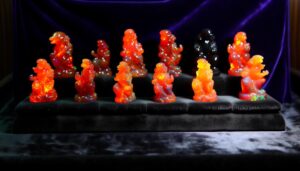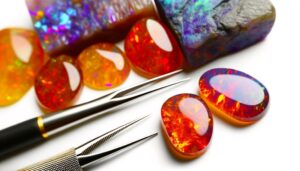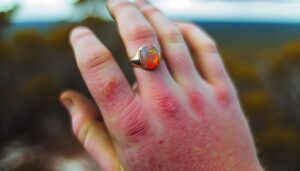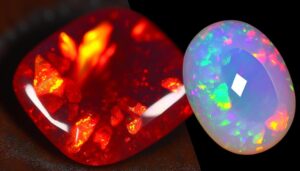Can You Get Fire Opals Wet?
You shouldn't get fire opals wet. They're composed of hydrated silica, with water content ranging from 3% to 21%.
Exposure to water can cause internal fractures, cloudiness, and affect their vibrant colors. Fire opals can absorb water, which may temporarily alter their appearance and weight.
While short-term water exposure isn't disastrous, long-term contact should be avoided to maintain their structural integrity. For cleaning, use lukewarm water and mild soap, but avoid soaking them.
Keep fire opals in a padded box with stable humidity to prevent cracking. Learn more by continuing.
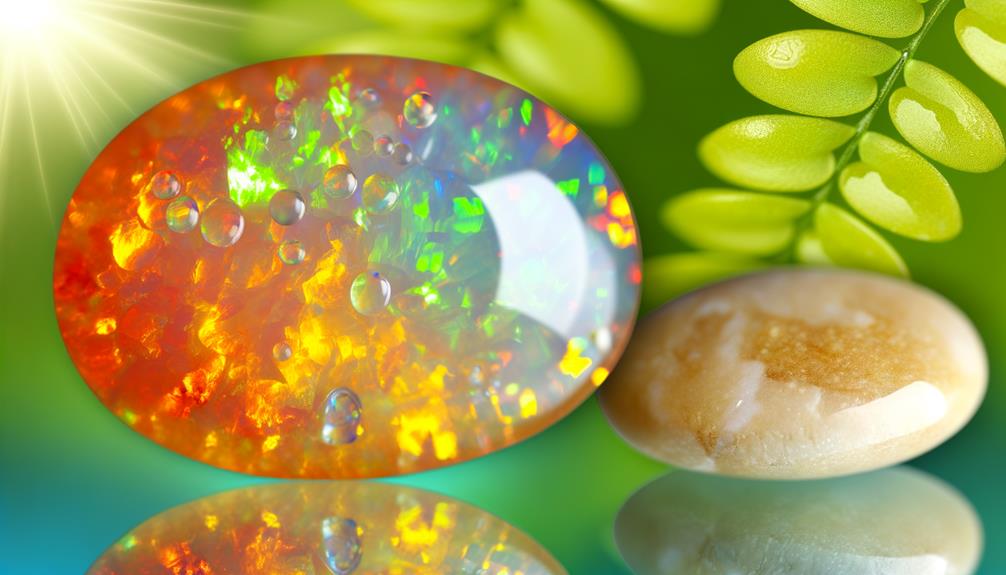
Key Takeaways
- Fire opals can absorb water, leading to temporary changes in color and transparency.
- Prolonged water exposure can cause microfractures and structural damage to fire opals.
- Short-term water exposure doesn't harm fire opals but may dull their appearance temporarily.
- Fire opals' hydrophane nature makes them sensitive to water, impacting visual characteristics.
- Proper drying after water exposure is crucial to avoid potential damage and cracking.
What Are Fire Opals?
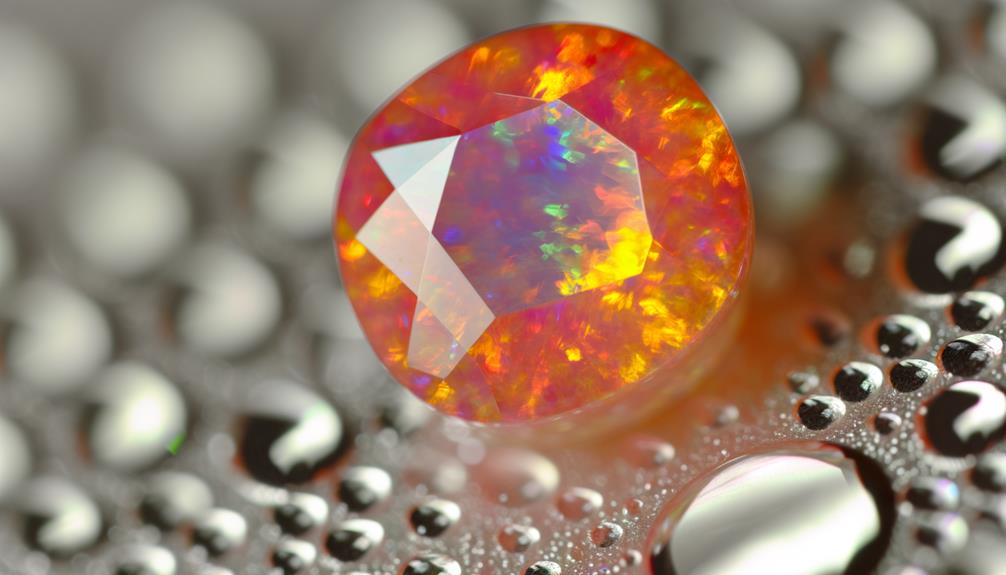
Fire opals, known for their vibrant play of color, are a type of opal that primarily comes from Mexico. You'll find that they're composed of hydrated silica, which means they contain a significant amount of water, typically between 3% to 21%.
Unlike other opals, fire opals are prized for their warm hues, ranging from yellow to orange to red. These stones are formed in volcanic areas where water interacts with silica-rich lava. The unique geological conditions contribute to their distinct coloration.
When you're handling fire opals, you should be aware of their water content, which can affect their stability. Understanding the composition and origin of fire opals is essential before delving into their care and handling specifics.
Fire Opal Characteristics
Fire opals are highly sought after due to their vibrant colors and varying degrees of transparency. Their hydrophane nature allows them to absorb water, which can affect both their appearance and durability. Due to their fragility, meticulous handling and care are necessary.
Fire opals exhibit a range of vibrant colors and varying degrees of transparency, making them highly sought after. Their hydrophane nature means they can absorb water, affecting their appearance and durability. Given their fragility, you'll need to handle and care for them meticulously.
Color and Transparency
The color of fire opals ranges from vivid reds and oranges to yellows, with a notable transparency that can vary from completely clear to slightly opaque. These colors are due to the presence of trace elements and the way light interacts with the internal structure of the opal.
When light enters the stone, it gets diffracted, creating a play of colors known as 'fire.' This phenomenon makes fire opals highly prized. The degree of transparency affects the stone's brilliance and can influence its market value.
Transparent fire opals are often more sought after, but slightly opaque stones can also be beautiful. Understanding these characteristics helps you appreciate the unique allure of fire opals.
Hydrophane Nature
Many fire opals exhibit a hydrophane nature, meaning they can absorb water and temporarily change their appearance. This characteristic impacts their color, transparency, and even weight. When a hydrophane fire opal absorbs water, it may become more transparent or its play-of-color can become muted. Understanding this behavior is critical for anyone handling fire opals, as exposure to water can alter their visual characteristics. Below is a table summarizing these changes:
| Hydrophane Fire Opal Behavior | Description |
|---|---|
| Color Change | May become duller or muted |
| Transparency | Can increase significantly |
| Weight | Increases when absorbing water |
| Drying Time | Varies from hours to days |
| Stability | Returns to original state once dry |
Knowing these traits helps you manage and appreciate your fire opal's unique qualities.
Fragility and Care
While understanding the hydrophane nature of fire opals is important, you should also be mindful of their fragility and the care they need to maintain their beauty. Fire opals have a hardness rating of 5.5 to 6.5 on the Mohs scale, making them vulnerable to scratches and impacts.
Avoid exposing them to extreme temperatures, as sudden heat changes can cause cracking. Store your fire opals separately from other gemstones to prevent abrasion. Regularly check for loose settings if your opal is part of jewelry.
Clean them gently using a soft cloth and mild soap, avoiding ultrasonic cleaners. By taking these measures, you'll guarantee your fire opals remain vibrant and intact for years to come.
Composition and Structure
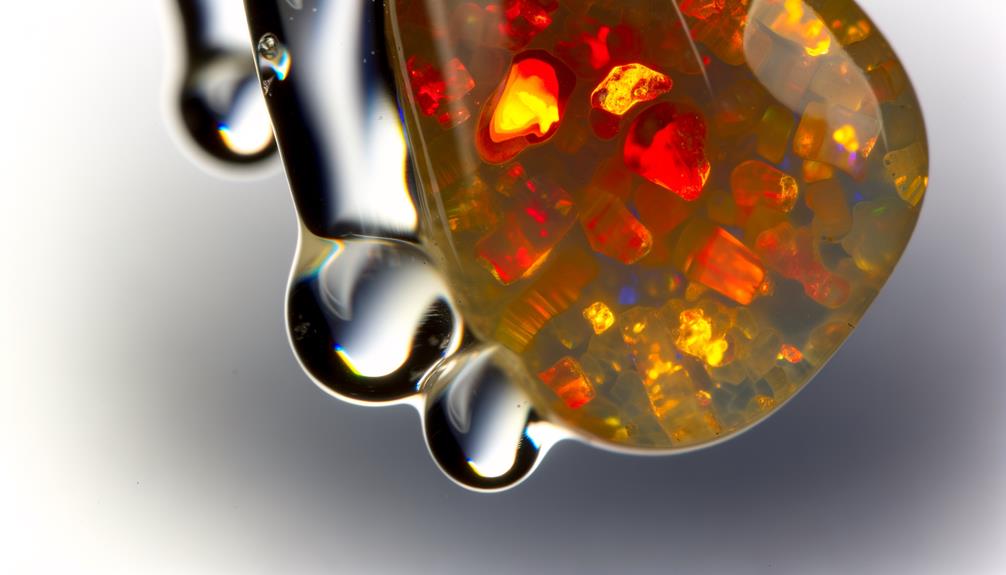
You should know that fire opals consist primarily of a silica gel matrix, which incorporates water content levels varying between 3% and 21%.
This inherent water content contributes to the stone's structural fragility. Understanding these factors is essential when determining whether exposing fire opals to water is advisable.
Silica Gel Matrix
The silica gel matrix in fire opals consists of hydrated silicon dioxide, which forms a microscopically porous structure. This porous nature enables the matrix to trap water molecules within its tiny voids, giving fire opals their distinctive play of color.
Unlike crystalline quartz, the non-crystalline, amorphous form of silica in fire opals lacks a regular atomic structure, resulting in its unique optical properties. You'll find that this gel-like composition is sensitive to environmental changes, particularly humidity and temperature.
The microscopic pores scatter light, creating the vibrant flashes of color known as opalescence. Understanding this silica gel matrix helps you appreciate why fire opals need special care, especially regarding exposure to water and potential drying.
Water Content Levels
Recognizing the significance of the silica gel matrix, you'll find that water levels in fire opals greatly impact their composition and structure. Typically, fire opals contain 3-10% water, which is essential for maintaining their vibrant play of colors.
When water levels fluctuate, the internal structure can expand or contract, affecting the opal's stability. High water levels make the opals more hydrated, enhancing their translucency and brilliance but also making them more prone to crazing.
Conversely, lower water levels can lead to a more stable structure but may dull the opal's appearance. Understanding these dynamics is crucial to evaluating the integrity and aesthetic quality of fire opals. Always consider water levels when appraising fire opals' overall value.
Structural Fragility Factors
In understanding fire opals' structural fragility, consider their unique composition of silica spheres and water molecules, which can make them susceptible to cracking and crazing.
These silica spheres are arranged in a microstructure that creates the stunning play-of-color fire opals are known for. However, the presence of water molecules within this structure is a double-edged sword. While it contributes to the opal's brilliance, it also means fire opals can expand or contract with moisture changes. This makes them vulnerable to temperature fluctuations and environmental humidity.
When you expose a fire opal to water, especially over prolonged periods, the risk of structural damage increases. Proper care and handling are essential to maintain their beauty and integrity.
Water Sensitivity
Fire opals possess a unique water sensitivity that can affect their structural integrity and appearance. Unlike other gemstones, fire opals contain a significant amount of water within their composition, ranging from 3% to 21%.
This internal water content makes them particularly susceptible to changes in environmental humidity and direct contact with water. When exposed to water, fire opals can absorb additional moisture, leading to potential expansion and contraction. These physical changes can create microfractures or exacerbate existing ones, compromising the gem's stability.
Additionally, water exposure can dull the opal's vivid play of color by altering the diffraction of light within its hydrated silica structure. Understanding this water sensitivity is pivotal for maintaining the quality and longevity of fire opals.
Risks of Water Exposure
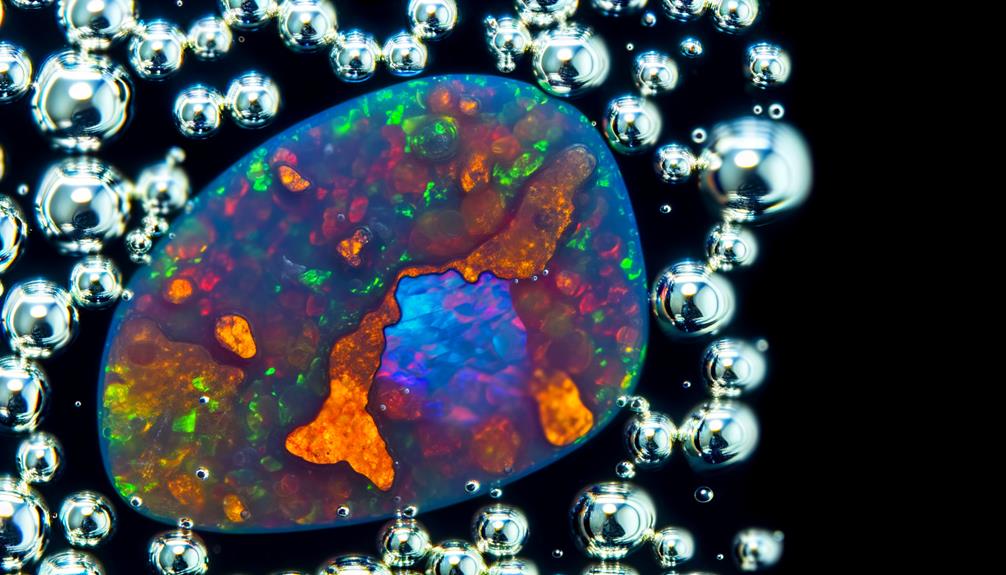
When you expose fire opals to water, you risk compromising their structural integrity due to their high water content.
Additionally, water exposure can lead to color change issues, making the opal appear cloudy or dull.
It's essential to minimize contact with water to preserve the stone's natural beauty and durability.
Structural Integrity Concerns
Water exposure can compromise a fire opal's structural integrity by causing internal fractures and cloudiness. As a hydrous silica mineral, fire opals naturally contain water. When you expose them to additional moisture, the stone can absorb it, leading to expansion and contraction within its microscopic structure. This process can create stress points that result in tiny fractures, diminishing the stone's clarity and making it more prone to breaking.
Additionally, trapped water molecules can cause a milky or cloudy appearance, detracting from the opal's brilliance. Ensuring that you keep fire opals dry is essential to maintaining their structural integrity and visual appeal. Proper care will help you preserve both the beauty and the durability of your fire opal jewelry.
Color Change Issues
Exposing fire opals to moisture can lead to significant color changes, often resulting in a dull or faded appearance. This occurs because fire opals contain a high percentage of water, typically between 3-10%. When exposed to additional moisture, they can absorb water, causing internal structural changes that affect their optical properties.
The vibrant, fiery play-of-color you admire can diminish, making the opal look lackluster. Additionally, abrupt dehydration after water exposure may cause cracking or crazing, exacerbating the color loss.
To maintain your fire opal's brilliance, avoid prolonged contact with water. Store it in a dry environment and clean it with a soft, dry cloth. By doing so, you'll preserve its unique visual appeal and structural integrity.
Common Myths Debunked
Many believe that fire opals can't get wet, but this is a common misconception. Fire opals are composed of hydrated silica, making them naturally contain water. Here are some myths debunked:
- Myth: Fire opals will dissolve in water.
- Truth: Fire opals are stable and won't dissolve in water.
- Myth: Water exposure permanently damages fire opals.
- Truth: Short-term water exposure doesn't harm them.
- Myth: Fire opals lose their color when wet.
- Truth: Any temporary color change reverses as the opal dries.
- Myth: All opals are equally sensitive to water.
- Truth: Sensitivity varies; fire opals are relatively stable.
- Myth: You must keep fire opals in oil to prevent damage.
- Truth: Proper storage without oil is sufficient.
Cleaning Fire Opals
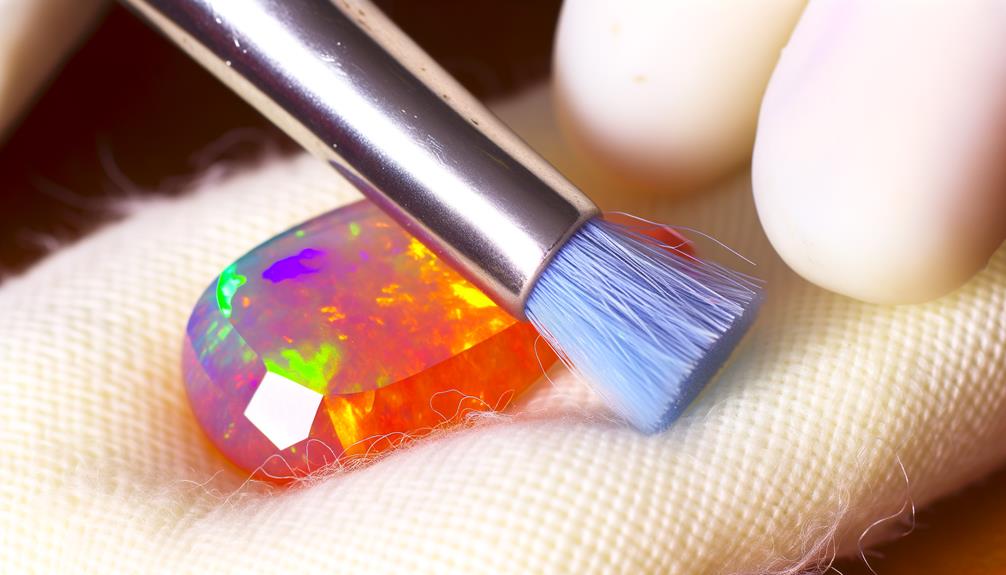
Cleaning fire opals necessitates a delicate approach to maintain their vibrant appearance and structural integrity. Begin by using lukewarm water and a mild, non-abrasive soap. Avoid harsh chemicals and ultrasonic cleaners, as they can harm the stone.
Use a soft, lint-free cloth or a soft-bristled toothbrush to gently scrub the surface. Rinse the opal thoroughly under lukewarm water to eliminate any soap residue. Pat it dry with a clean, soft cloth, avoiding excessive rubbing.
Don't immerse fire opals for extended periods, as prolonged exposure to water can weaken their structure. Regular maintenance guarantees your fire opals remain stunning and intact. Handle them with care to maintain their natural beauty and brilliance.
Safe Storage Tips
Storing fire opals correctly is crucial to preserving their luster and preventing damage. Follow these tips to secure your fire opals remain beautiful and intact:
- Use a padded jewelry box: Cushioning prevents scratches and physical damage.
- Keep away from direct sunlight: Prolonged exposure can fade their vibrant colors.
- Maintain stable humidity levels: Extreme dryness can cause cracks; use a humidity-controlled environment.
- Separate from other gemstones: Store fire opals individually to avoid scratches from harder stones.
- Avoid temperature extremes: Sudden changes can cause thermal shock, leading to fractures.
Wearing Fire Opal Jewelry
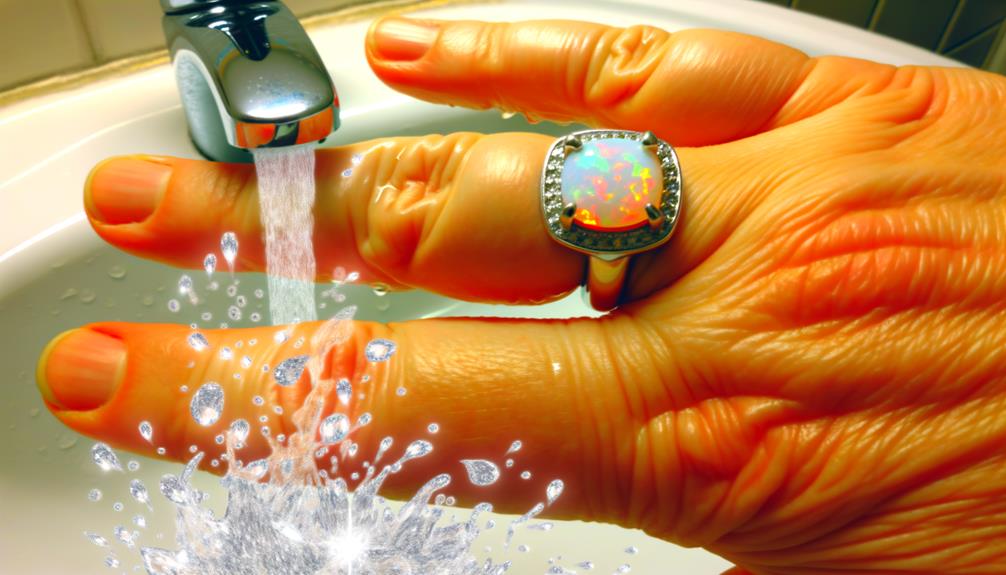
When wearing fire opal jewelry, make sure you protect the stones from harsh chemicals and physical impacts. Fire opals are relatively soft, rating 5.5 to 6.5 on the Mohs hardness scale, making them susceptible to scratches and fractures. Avoid wearing them during activities that might expose them to knocks or abrasions.
Also, keep fire opals away from household cleaners, perfumes, and hair sprays, as these substances can damage the stone's surface or alter its color. Always put on your fire opal jewelry last when getting ready to minimize exposure to these chemicals.
Regularly inspect your jewelry for any signs of wear or damage, and consider professional cleaning and inspection to maintain its brilliance and integrity.
Handling With Care
To handle fire opals with care, always use a soft, lint-free cloth to gently wipe the stones after each wear. This helps remove any oils or residues that can dim their vibrant colors.
Additionally, avoid exposing fire opals to sudden temperature changes, as they can cause cracking. Store them separately from other jewelry to prevent scratches.
Avoid ultrasonic cleaners as these can harm the internal structure of fire opals.
Minimize exposure to chemicals like perfumes, lotions, and household cleaners, as they can damage the stone.
Keep fire opals dry as they are porous and can soak up water, leading to potential damage.
Handle them with clean hands to prevent dirt and oils from transferring onto the stone.
Use padded storage to cushion the fire opals and protect against accidental impacts.
These steps guarantee your fire opals remain pristine.
Best Practices for Maintenance
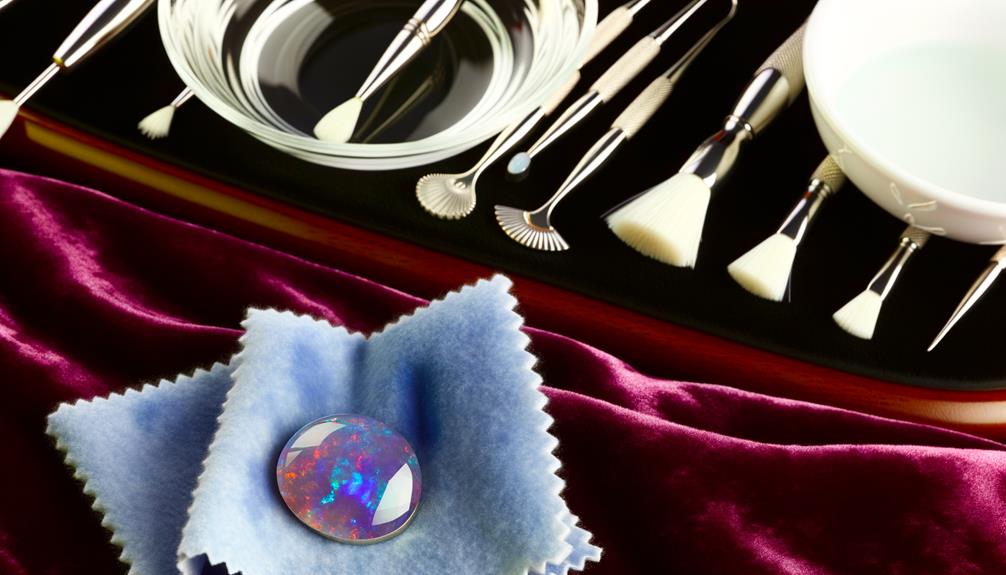
Regularly examining your fire opals for signs of wear or damage helps them stay in peak condition. Start by inspecting the surface for scratches or chips. If you notice any, address them promptly to prevent further deterioration.
Store your fire opals in a dry, cool place, away from direct sunlight and extreme temperatures, which can cause them to crack or fade. Use a soft, lint-free cloth to gently clean your opals, avoiding harsh chemicals or abrasive materials.
When wearing fire opals, refrain from exposing them to water, as prolonged exposure can weaken their structure. Finally, consider using a separate compartment in your jewelry box to prevent contact with harder gemstones that might scratch your opals.
Expert Care Recommendations
Experts recommend routinely examining your fire opals under magnification to identify any early signs of structural compromise. This proactive approach helps you address issues before they escalate, ensuring the longevity of your gemstones.
Here are some expert care recommendations:
- Avoid prolonged exposure to water: Fire opals are sensitive to liquids which can lead to cracks.
- Store in a padded jewelry box: This protects against physical damage and environmental fluctuations.
- Maintain humidity: Place a damp cloth near stored opals to prevent dehydration.
- Clean gently: Use a soft, damp cloth and avoid harsh chemicals.
- Regular professional inspections: Schedule annual check-ups with a jeweler to catch and address any potential issues.
Following these guidelines helps preserve the integrity and beauty of your fire opals.
Conclusion
Lastly, handling fire opals is akin to tending to a fragile orchid—both demand gentle, meticulous care.
Always steer clear of exposing your fire opal to moisture to avoid possible harm.
Following recommended maintenance guidelines, like storing in a dry location and cleaning with caution, will maintain their beauty.
When uncertain, seek advice from a specialist to guarantee your fire opal stays striking and unharmed for years ahead.
Your attentive care will sustain its vibrant radiance.


